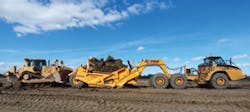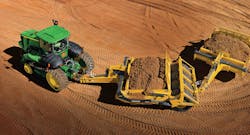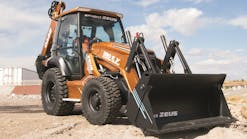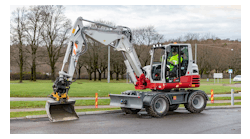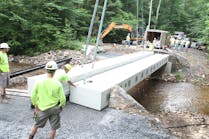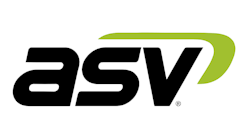Caterpillar points out in its marketing literature that towed scrapers are a good choice for contractors removing lower-density materials in distances under 2,500 feet, materials with a bank density of less than 3,000 pounds per yard, and no uncompressible items such as large rocks or stumps.
In a slowly rebounding market, grading and excavation contractors are seeking to become the lowest-cost producer with towed scrapers, notes Kelly Goossen, sales manager for K-Tec.
“K-Tec scraper sizes allow the end user to move dirt at a lower cost due to the scraper capacity. It’s all about production,” Goossen says.
And efficient production is what scraper manufacturers such as K-Tec are responding to with respect to trends they are noting.
Mark Miskin, president of Miskin Scraper Works, says contractors are becoming increasingly educated about scrapers, now viewing them with a more critical eye.
“Contractors are finding out that a pull scraper is more than a “˜box that holds dirt,’ that there are differences in scraper design that cause differences in production, performance and durability,” Miskin says.
A trend noted by Jessica Gallagher, marketing and inside sales coordinator for Ashland Industries, is that customers with all sizes of jobs and tractors are becoming more interested in doing their own scraper work.
“In the past, professional dirt contractors were seen as a must, but today trends are shifting toward accessible dirt-moving for everyone from farmers to heavy industrial contractors, with machines ranging from skid-steers to large articulated tractors,” she says.
Additionally, contractors have become increasingly conscious of their costs per yard.
“They’re looking for new ways to “˜move more for less’, which is our motto,” Gallagher says.
Mark Oliver, product-marketing manager for scraper systems for John Deere Construction and Forestry, notes a rise in demand for sophisticated productivity solutions “as the pull scraper concept continues to expand its market share among more conventional earthmovers.”
Rudy Martinez, the towed scraper product/commercial manager for the mining products division of Caterpillar, says he’s seeing a trend toward larger towed scrapers being pulled by an articulated truck.
Jamie Meier, marketing manager for Icon Industries, says the market for scrapers is getting better.
“With the slowdown of the economy, there were a fair number of scrapers out there that were in rental fleets,” he says. “We’re starting to see interest in new equipment. A lot of dealers have washed through the rental fleets, and we’re starting to get guys who are starting to get back in the game and pick up jobs and some of the new units again, which is refreshing.”
The jobs are being secured in the landfill and road construction markets with the housing market and shopping malls being “hit and miss,” Meier says.
Goossen is noticing more of K-Tec’s scrapers are being used in mining projects, pulled by ADT rock trucks.
K-Tec offers contractors scrapers ranging from 25 cubic yards to 54 cubic yards.
One such end user is Chris Galloway, owner of C.G. Construction in Davis, CA. His company uses K-Tec scrapers as part of its services in creating habit restorations for endangered species.
“We use the K-Tec scraper to move earth and build wetlands,” Galloway notes. “The advantages are they can go into wet material and soft ground versus a motor scraper that won’t. We can separate the scraper from the tractor and use the tractor for other functions. We don’t have an asset tied up in just one task.”
While going the distance with pull-type scrapers can be a limitation, Galloway says K-Tec addresses that through its models 1243 and 1254, scrapers pulled by a haul truck.
“Those will compete with the motor scraper,” he says. “You can get the same speed out of those that you can get from a motor scraper.”
In order to maximize the performance of the K-Tec scraper, Galloway uses drop center blades to provide easier loading.
“The nice thing about these is we can push them with large bulldozers,” he adds. “We put GPS on them for grade control.”
Galloway, who’s been running K-Tec scrapers since 2006 and continues to build the fleet, says he’s chosen the K-Tec scraper for its large single pan and the support he’s received from the company. Maintenance is minimal, he says.
“There are wear items like cutting edges and we rebuild the hitch once a year and that’s about it,” he says, adding that he also performs the minimal maintenance required for the grease points.
K-Tec has six grease points of which two need to be greased once daily, while the other four are greased every 250 hours, says Goossen.
“All the other pivot points have greaseless bushings that need replacing once to twice a year depending on the hours of use and soil conditions,” says Goossen. “This minimal maintenance makes for more time scraping and less time working on maintaining your scraper.”
Ashland Industries manufactures earthmovers, track-loader scrapers, and equipment parts. The company supports its machines with preventative maintenance and follow-up, specializes in large weldments and heavy fabrication, and serves as the exclusive supplier of CNH drawbars for the company’s plant in Fargo, ND.
Ashland scrapers range from capacities of 2.5 cubic yards to 20 cubic yards.
“Our ejector scrapers allow superior placement of material and can accommodate a wide range of soil types,” says Gallagher.
Jeff Kocher is an Ashland dealer who also uses the product in his company’s operations.
His company, Complete Farm Conservation Operation Inc. in Lawrenceville, IL, is an excavation drainage company that also sells overhead irrigation, center pivots.
Kocher says he likes the maneuverability of the Ashland scrapers.
“You can get around with softer ground a lot better than the big self-propelled units,” he says. “We also have some of those. We hardly use them. With the Ashland scraper, you’ve got your power unit or tractor and you can unhook it and use it for something else.”
Kocher says he doesn’t see any limitations in using a towed scraper, even in going some distance with it.
“We’ve done some levy repairs, and we’ve hauled dirt with them for about a mile, a mile and a quarter,” he says.
End users favor the easy loading and unloading, Gallagher says.
The machine offers a fast blade response through the lift cylinder placement, offering larger loads with fewer RPMs.
“Our tandem models also help significantly increase production on big jobs,” says Gallagher. “On Ashland’s heavy industrial scrapers, users love our 360-degree super-swivel hitch for maximum range of motion.”
Less than 10 minutes per day is needed for maintenance to grease the machine at centralized grease banks, Gallagher says.
“Wearable parts, such as blades, need to be monitored for eventual maintenance, but Ashland scrapers feature thicker blades and plow bolts for long-lasting use,” she says.
“We just grease them and check the axle bearings maybe once a year,” says Kocher.
The Caterpillar towed scraper model line offers towed scrapers pulled by track-type tractors or agricultural tractors, including the TS180, 18.8 lcy (two-tire), the TS185, 19.0 lcy (four-tire), the TS220, 23.5 lcy (two-tire), and the TS225, 23.5 (four-tire).
The TS series is built on the platform of the former E-Ject Systems scrapers. Features include high-strength, abrasion-strength, and resistant-strength steel used throughout the scraper bowl wear surfaces, along with walking beam suspension, adjustable cutting angle, and standard radial tires and brakes.
Caterpillar offers a wide range of configurations for scrapers.
Towed scrapers provide the lowest cost per ton to move dirt in the right applications, says Martinez, adding the system makes it possible to disconnect the scraper and use the pulling tool for other uses when the user no longer needs to haul dirt.
Another advantage is that maintenance is minimal as it doesn’t have a power train like a machine would, Martinez adds.
On the other hand, towed scrapers do have limitations. “They must have short hauling distances and the soil needs to be in the correct range to maximize this system,” says Martinez.
John Deere recently introduced new scrapers to its 9R/9RT Scraper Special Series Tractors: the 9460RT, 9510RT, and 9560RT, as well as three-wheeled models 9460R, 9510R, and 9560R.
The full line is equipped with a fuel-efficient, high-torque IT4 13.5L PowerTech PSX engine of 460 to 560 horsepower.
The 9460RT, 9510RT, and 9560RT are equipped with the Durabuilt 5500 Series Scraper rubber track in a 30-inch width. The tracks are manufactured with four-ply layers and are designed for tough debris and resistance to high side loads.
The internal construction is enhanced with a heavy-duty main cable and optimized for puncture resistance.
All 9RT Series Track Tractors are equipped with an AirCushion suspension system that isolates the entire front chassis when operating on harsh, uneven terrain.
The entire system is fully automatic, requiring no operator adjustment or special care. The system is designed to allow the tractor to travel faster over rough terrain while increasing operator comfort.
The 9R/9T Series Tractors are fitted with a new CommandView II Cab that provides fingertip controls and is designed to offer visibility, convenience and productivity.
Cab improvements include a 10% increase in overall cab volume, 7% more glass area, and four times more storage area over the previous cab design.
John Deere has removed the right-hand console from previous models to improve visibility and provide more space. In its place, the company added a right-hand convenience area that includes two cup holders, an ISO connector, power outlets, an MP3 jack, and storage for such items as cell phones and MP3 players.
The functions and features formerly located on the right-hand console were relocated to the redesigned CommandARM, including a new 7-inch color CommandCenter display.
The CommandArm provides fingertip controls of tractor functions, including throttle, transmission speed and direction and selective control valves. Additional adjustments and configuration settings are made on the optional touch-screen capable GreenStar (GS3) CommandCenter display.
John Deere incorporated the Powershift transmission with Efficiency Manager as base equipment on all 9R/9RT Scraper Special Tractors. Through a thumb wheel located on the transmission lever, the Efficiency Manager gives pinpoint ground-speed control by allowing the operator to set speeds for transport or when the operator is not in the cut loading dirt.
The program can make appropriate adjustments based on inputs received from the tractor and matches engine and transmission performance to ground speed for fuel efficiency.
On the 9R/9RT Scraper Series Tractors, John Deere includes a new common hydraulic/transmission/axle oil reservoir including improved oil level management and a common oil reservoir, decreasing the number of checkpoints and allowing the operator to maintain the proper oil level for all conditions.
The 9R Wheel Tractor now has two hydraulic oil filters instead of one, increasing the service interval from 750 hours to 1,500 hours.
Other improved features on the scraper tractors include enhanced fender coverage, a standard tow cable, and upgrades to the frame, chassis, and axles.
The foundation of the 9R Scraper Special Series is a three-section frame. Axle flats integrated on 4.72-inch diameter axles offer improved wheel attachment and reduced maintenance.
The axle lubrication system features pressurized cooled and filtered oil. The tow cable is included as base equipment.
John Deere’s offering of tractor, scraper, and integrated technologies is designed to reduce input and operating costs to save time and money, says Oliver.
To that end, John Deere offers AutoLoad, a push-button loading system, as well as products such as JD Link and Service Advisor Remote.
“Our scraper-system machine lineup has also adapted to include new features like rubber track tractors and triple scrapers, all customer-driven requirements,” he adds.
The company’s towed scraper models are being used on construction sites, in mines moving overburden, on farms in water management applications, and in landfills.
“Our scraper tractor offering includes four-wheel drives, rubber-track tractors, and even row-crop ag tractors,” says Oliver. “We can move anywhere from 15 to 55 cubic yards per cycle with a list of options that allows customization for any set of conditions.”
Large construction customers favor pairing the large four-wheel drives such as the new 9560R Scraper Special with the 2112E ejector scrapers in tandem for the wide range of tough conditions they face, Oliver notes.
“Options like the rear push block and super overflow guard are a must for these customers,” he says. “Other customers in sandier conditions favor our Carry All lineup headlined by the 1812C. This machine can be pulled in triple scraper applications and work beautifully behind the new 9RT Scraper Special rubber track tractors for those highly abrasive, loose underfoot materials.”
The JDLink system continuously collects and transmits machine data for machine management via mobile phone technology. The system enables the preventive maintenance and remote diagnostics of tractors, as well as the tracking of machines working on multiple job sites.
John Deere Scraper tractors have periodic service intervals.
“Our scrapers should be greased every 10 hours with wear items replaced as needed,” Oliver says. “Our scraper systems can direct load, carry, and spread material on grade, doing the work of several conventional pieces with one system. This greatly reduces overall maintenance costs from a fleet perspective.”
Miskin Scraper Works scrapers were pulled by horses when the company began manufacturing them in 1917.
Today, the company makes a variety of products, with construction-grade scrapers having the capacity of 9, 17, 19, 20, and 26 yards that can be pulled as singles or in trains behind a single tractor.
“Twenty years ago, Miskin split their scraper products into two separate lines-one for construction, the other for agriculture,” says Miskin. “We found that if we tried to build the scraper cheap enough for a farmer, who will use it only a few weeks a year, it was not heavy enough to satisfy the contractor.”
The construction line has evolved into a heavy-duty construction product that meets customer expectations for construction grade equipment.
“Contractors stay away from the lower-priced farm scrapers because of durability concerns,” Miskin says.
The range of performance of the pull scraper is similar to that of a self-propelled scraper, except that “pull scrapers will work in softer and wetter conditions because of their improved floatation,” says Miskin. “They will also work well with loose, sandy materials that do not stack up well inside a self-propelled scraper. Some models are designed to be push-loaded by a dozer and can work in the same conditions that a push-loaded self- propelled scraper work in.”
End-users favor productivity in lower cost per yard and material moved per hour, as well as the ability to work in adverse conditions and with difficult-to-load material, says Miskin.
“The flexibility to run as singles, or in trains of two or three depending on haul length and changing job-site conditions” is another favored benefit, he adds.
To avoid downtime, daily greasing is recommended. “However, the Miskin D series construction scrapers feature replaceable bushings for an easy repair if daily greasing is neglected,” Miskin says. “Wheel bearings on a Miskin do not require scheduled service; just take an oil sample annually. Cutting edges and other wear items should be checked weekly for wear and replaced as necessary.”
When it comes to pull-type scrapers versus a self-propelled scraper, the matter comes down to the cost of moving material, says Meier.
“That’s the big advantage of a pull-type scraper: It can really lower your costs per yard in moving material,” says Meier.
In addition to cost savings per yard, pull-type scrapers offer flexibility, Meier adds.
“Contractors will find that their fuel costs will be down versus going to the self-propelled units, where sometimes they may need two engines, with the self-propelled unit pushing and pulling in order to get that to load,” he says. “With our pull-type scraper, it will self-load. You can push from the rear, but generally our guys are using one power unit to pull it and it will load itself.”
Contractors can get into a scraper for less money by going with pulled scrapers, Meier points out.
“It works very well in lighter soils, but certainly when a person has thicker soils, the eject wall system is much preferred where we can take the rear wall and kick it out,” he says.
Icon Industries manufactures a 400 and an 800 series in scrapers. The 400 series is smaller, with model 414 featuring 14-cubic-yard capacity, a 10-foot cut, 240 to 400 tractor engine horsepower, a fixed-hinge bit, a rollout eject, and 26.5-by-25 tires. It comes with optional brakes and a 360-degree hitch.
Model 418 features 18 cubic yard capacity, an 11-foot cut, 350 to 500 tractor engine horsepower, a fixed hinge bit, a rollout eject and 20.5-by-25 tires. It comes with optional brakes and a quick attach hitch.
The Model 819 scraper features 19 cubic yards maximum capacity, is front lowering with hydraulic disc brakes, a Swingwall eject, two 29.5 tires at the rear, a 10-foot cutting width, an overall width of 10 feet, 11 inches, two-valve sequencing hydraulics, and a 600-horsepower Quickattach hitch.
The Model 821 scraper has a 21-cubic-yard capacity, is front lowering with hydraulic disc brakes, a Swingwall eject, two 20.5 tires and two 23.5 tires offset on a dual plane at the rear, an 11-foot cutting width, an overall width of 11 feet, 11 inches, two-valve sequencing hydraulics, and a 600-horsepower Quickattach hitch.
Meier notes that most contractors are heading in the direction of front-lowering systems.
It “will give better depth control versus a rear-lowering system,” he says. “We have both in our arsenal as far as being able to handle the wetter, stickier clays, and the rear-lowering scraper is more of an economical unit.”
The transport width, kept low on the 800 models, enables the equipment to be easily moved from one job to another, Meier notes.
The only limitation of a pulled scraper is the travel distance of dirt hauling, Meier says.
When it comes to distances less than a mile, “Certainly, the self-propelled guys can run faster from time of pick up to drop, but usually we’ll load faster than what they will and we’re more maneuverable than what they are,” he says.
“Clearly on a half-mile haul, we’re going to win that battle,” he adds. “Somewhere in-between there, once you get to greater than a mile, they’re probably going to win some efficiencies on speed. We have a dampening system to absorb the shock when we’re loaded. That will help smooth the ride out for our scraper.”
Maintenance is optimized by the Icon Industries’ ejection and Swingwall system, Meier says.
Other features that help maintenance is the ease of changing the rear tires, Meier says.
“All of our hoses and cylinders are covered and protected to protect it from the elements,” he adds.
Bonnell Industries manufacturers the “Perfect Road Maintainer” under the banner of Model 272 Road Drag, which levels off the ground surface.
The 272 is best used to maintain secondary gravel roads or construction site roads, says Joe Bonnell, company president. “The 272 requires loose material to move through the blades to mix and distribute the loose material along an uneven road surface. This mixing of material and distribution of material will fill in the potholes and the wheel ruts.”
Bonnell says users like the Road Maintainer for ease of use, as operators do not need to be experienced to run the unit.
Also, a 272 Road Maintainer will save contractors from having to use a motor grader.
“The Road Maintainer is quick; you can run along about 15 mph more or less, determined by the road conditions and the amount of loose aggregate,” says Bonnell.
The company offers various sizes of Road Maintainers. Bonnell says the only maintenance required is wheel-bearing grease.
“Wearable items are the cutting edges, tires, lift cylinder, and the rear blade adjustments,” he adds.
In choosing the right scraper for the job, the three most important factors are soil type, tractor horsepower, and needed width-of-cut, says Gallagher.
Bonnell agrees width needs are important.
“The 272, our smallest unit, operates 8 feet wide to 10 feet wide,” says Bonnell. “The Bonnell 572 Road Maintainer operates at a fixed width of either 10 feet or 12 feet wide.”
Most contractors prefer a scraper that is under an overall width of 12 feet so that it is easily transported between jobs, Miskin says.
“For larger projects, they can be more productive with larger 26-yard scrapers,” he adds. “They like a scraper that is easy to load so it doesn’t pull the guts out of the tractor. They want a scraper that is durable and reliable and that does not cause downtime.”
Kocher says width is important to him in choosing the right scraper for his company’s work.
“If you’re digging a waterway, you consider the bottom width, how tight your working area is,” he says. “We like the narrow ones for the work we do because we dig a lot of waterways, parabolic-shaped and trapezoidal. On the bottom width, if you get a scraper 10- to 12-feet wide, and you’re digging a parabolic waterway, then it’s hard to shape your bottom out and keep it rounded right,” he says.
Contractors should consider ground conditions, haul length, and the power unit, Goossen says.
“Soil such as soft, hard, rocky, sandy, clay, and topsoil conditions are all considerations when considering a scraper,” Goossen says. “Then you have to factor in the moving distance of the material. You also will need to determine whether the fleet will use an Ag Tractor or ADT Power Unit.”
Upon selling a scraper, K-Tec sends its training staff to assist in training new operators.
In choosing the right scraper for a job, a contractor should start with the specific application and match the size and amount of scraper systems that best fit the project, Oliver says.
“He should also make sure that the tractors and scrapers are appropriately paired based on size and power,” he adds. “Next, a contractor should look at ground conditions. Certain scrapers and blade configurations work better than others when conditions change. Ejectors are better in sticky clays, while Carry-Alls shine in sand.
“Lastly, look at machine options and integrated solutions like JDLink, iGrade, and AutoLoad. John Deere offers exclusive options and solutions that allow contractors to zero in on peak productivity.” Once contractors choose the right scraper for the job, maximizing its performance is key to its efficiency.
Optimizing performance is all about configurations, Oliver says.
“Working with your dealer and the factory to ensure that the right products with the right features are configured for your application can make the biggest impact,” says Oliver, adding that John Deere dealers work with customers after a sale to maximize operator productivity and uptime through training and support.
To get maximum performance out of the scrapers, “Pay attention to your cutting edges, make sure it pulls good and keep up the maintenance well so it functions properly, keeping it greased and keeping the pins and bushings checked in it for wear,” Kocher says.
Miskin says the best ways to maximize a scraper’s performance is to make shallow cuts at higher speeds.
“Keep the loading area flat and smooth,” he says. “In the unloading area, use the scraper to spread the material in smooth lifts instead of dumping in a rough pile. This will allow faster travel over the unloading area and more even compaction.”
Matching a tractor and scraper is important in maximizing the scraper’s performance, Gallagher says.
“Ashland has a close relationship with CNH as the exclusive supplier of their tractor drawbars, and this relationship helps us offer the whole package of knowledge to our customers on how to pair their tractor/scraper for maximum performance,” she says.
“Weight transfer and proper balance are extremely important to performance. We also take the time to help our customers choose the best scraper to tackle the particular soil type they’ll be moving,” Gallagher adds. “This helps reduce stress, wear, and downtime on their machine. Tandem hook-ups also help move more material with less effort.”
Bonnell notes that contractors are looking for efficiencies out of every pass of operation to maximize operations. The best way to do that with the 272 Perfect Road Maintainer is by operating it in the best of conditions, he says.
“Operate just after a rainfall when the material will move better or easier,” he says. “In dry conditions, you may pull the Bonnell 272 behind your motor grader to maximize each pass of operation of the motor grader. The 272 will catch the windrow left behind the motor grader and strike it off without another pass with the motor grader.”
